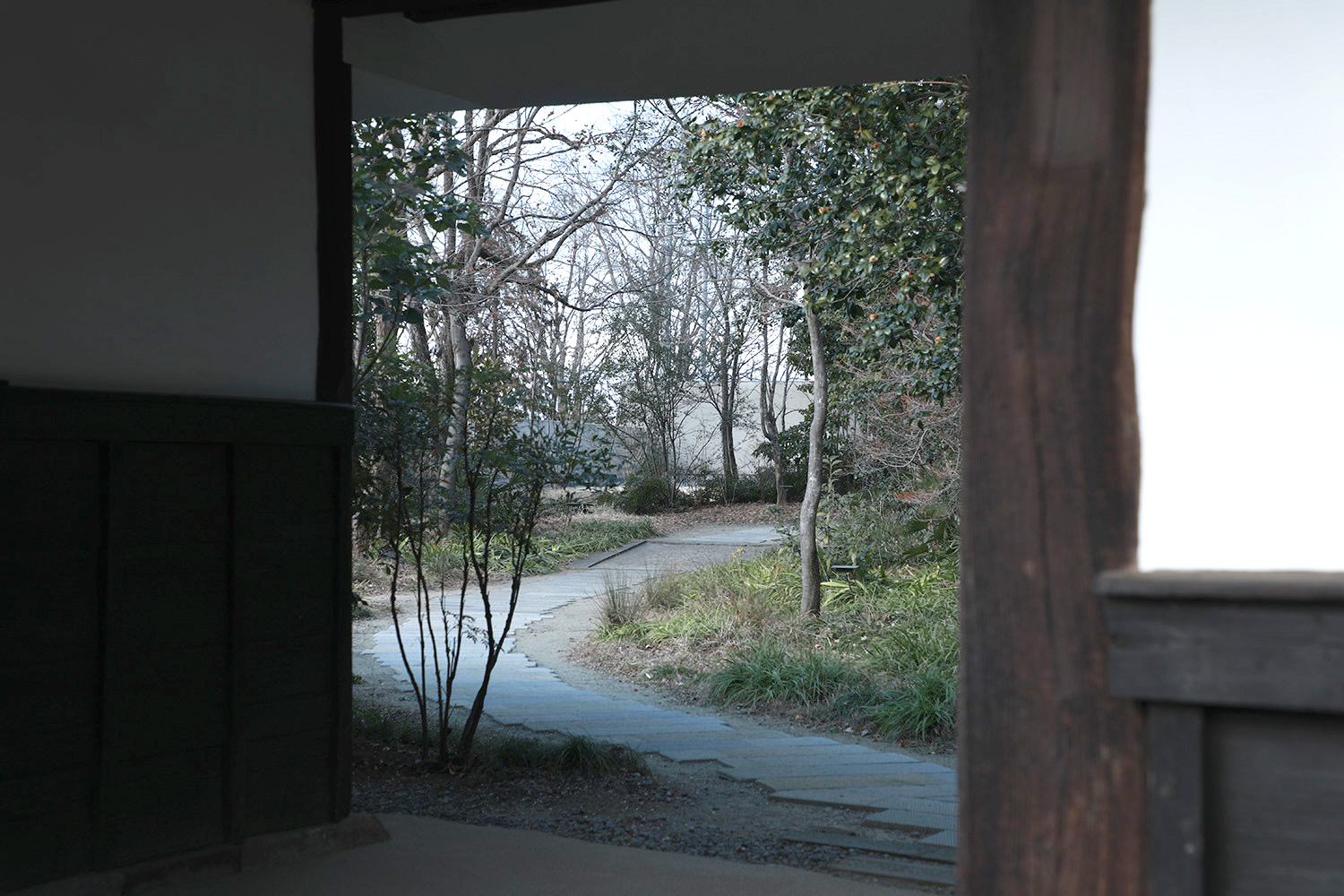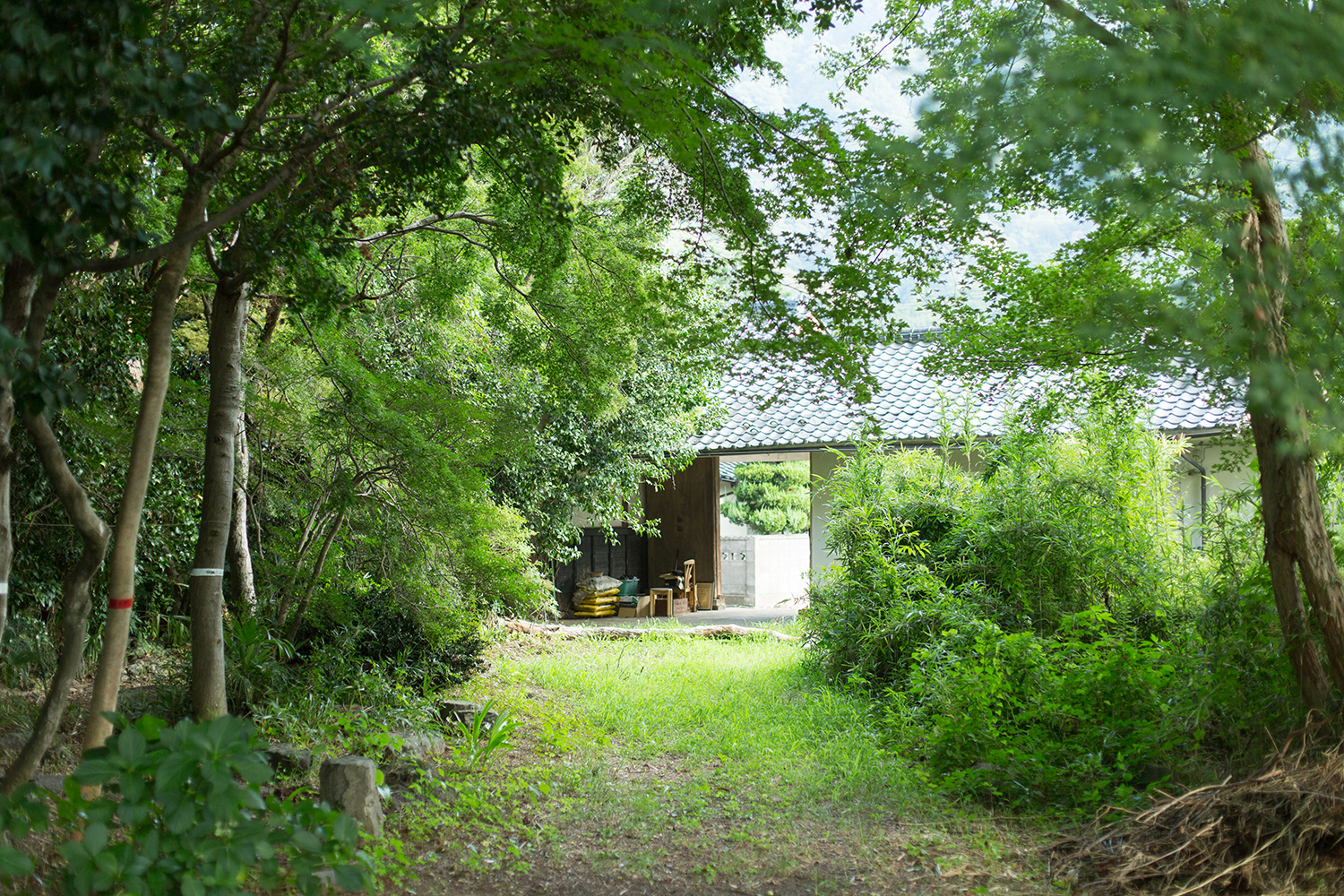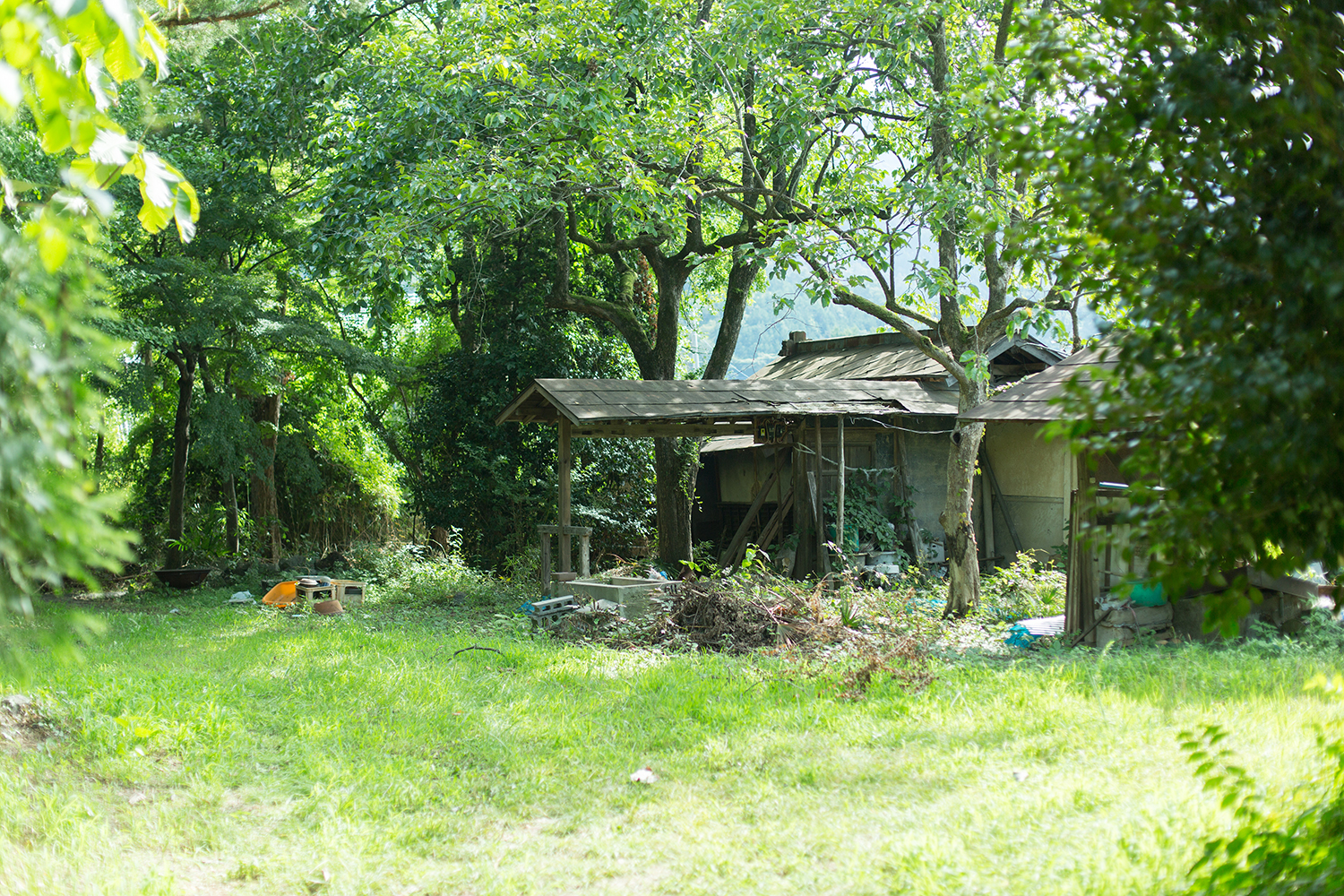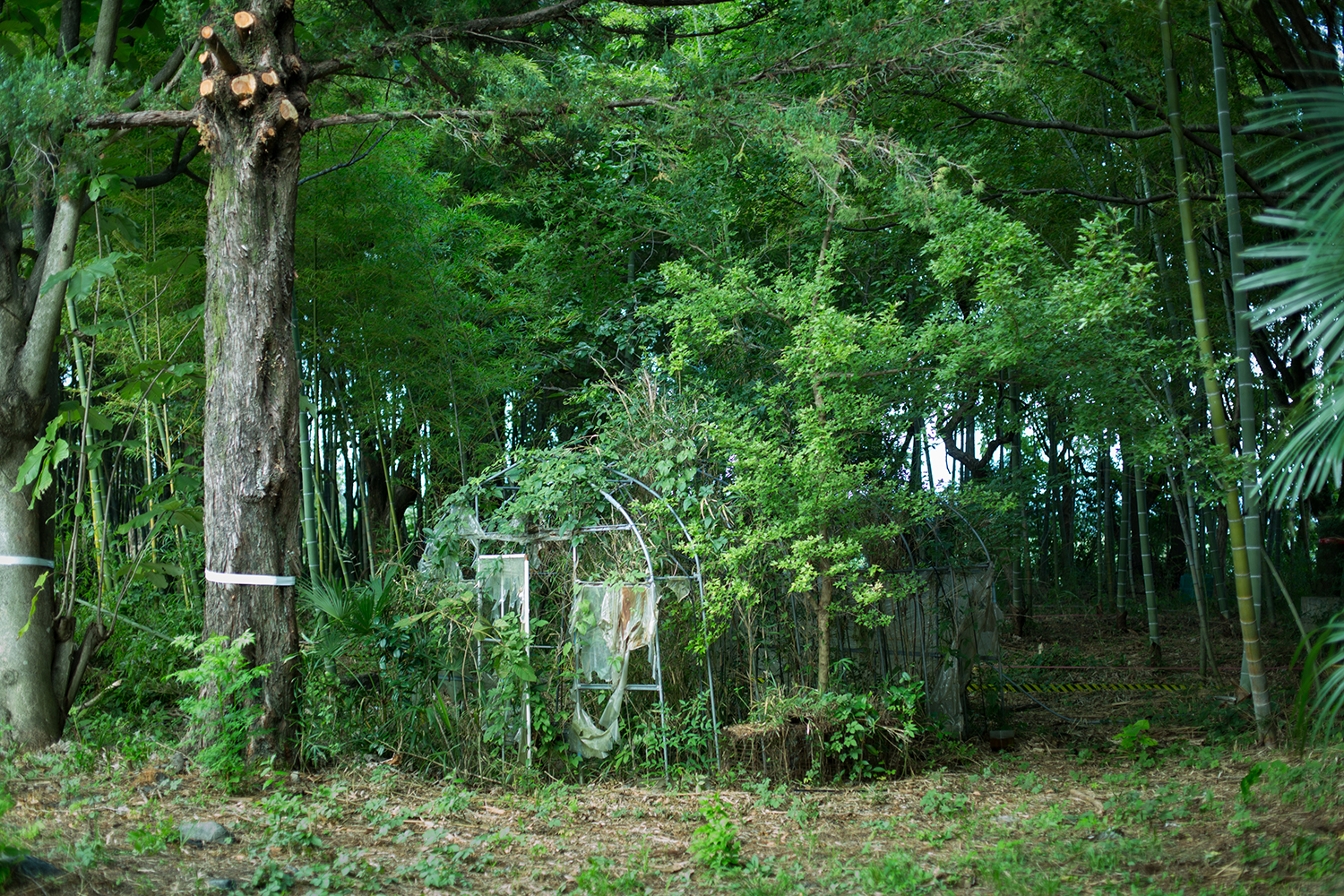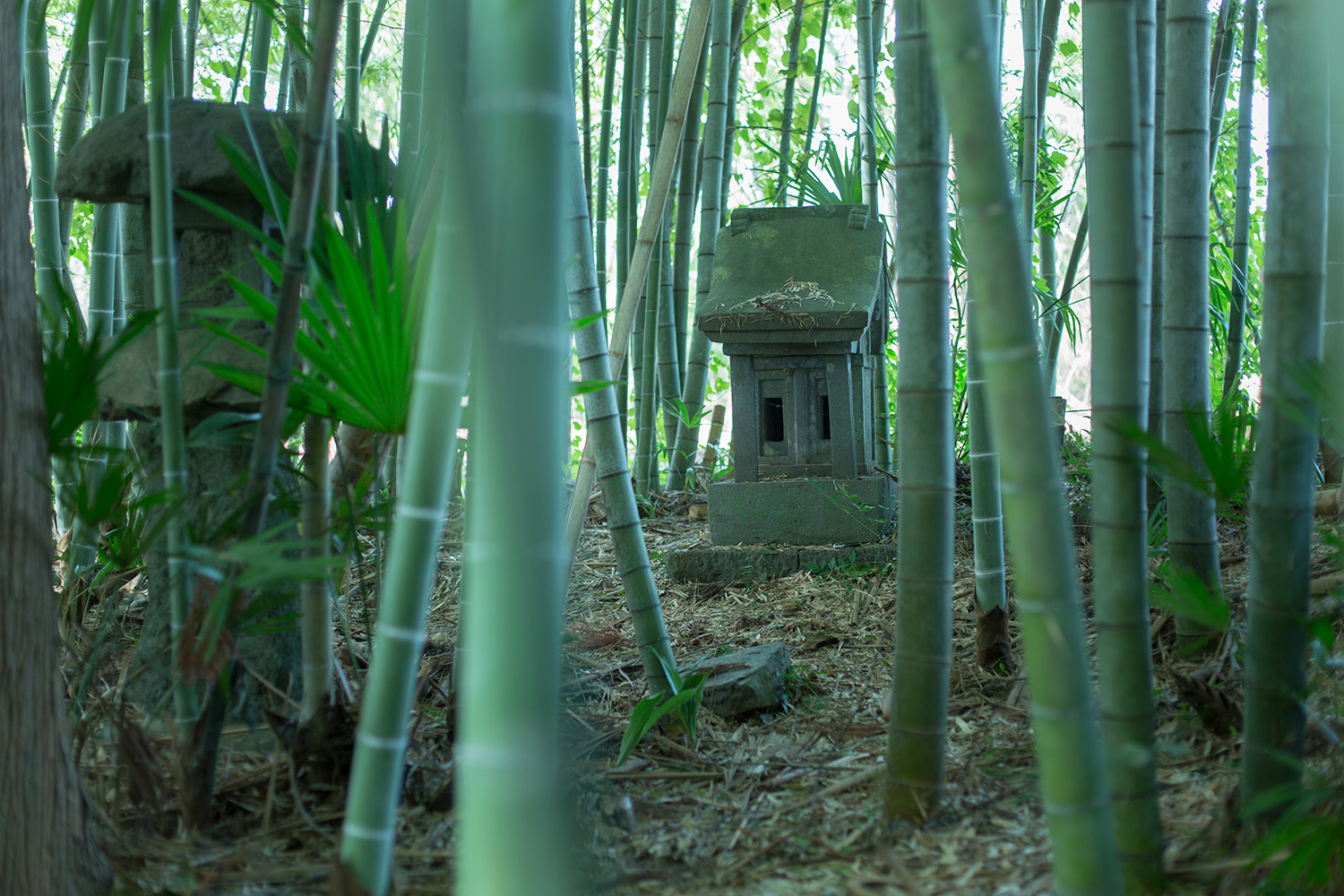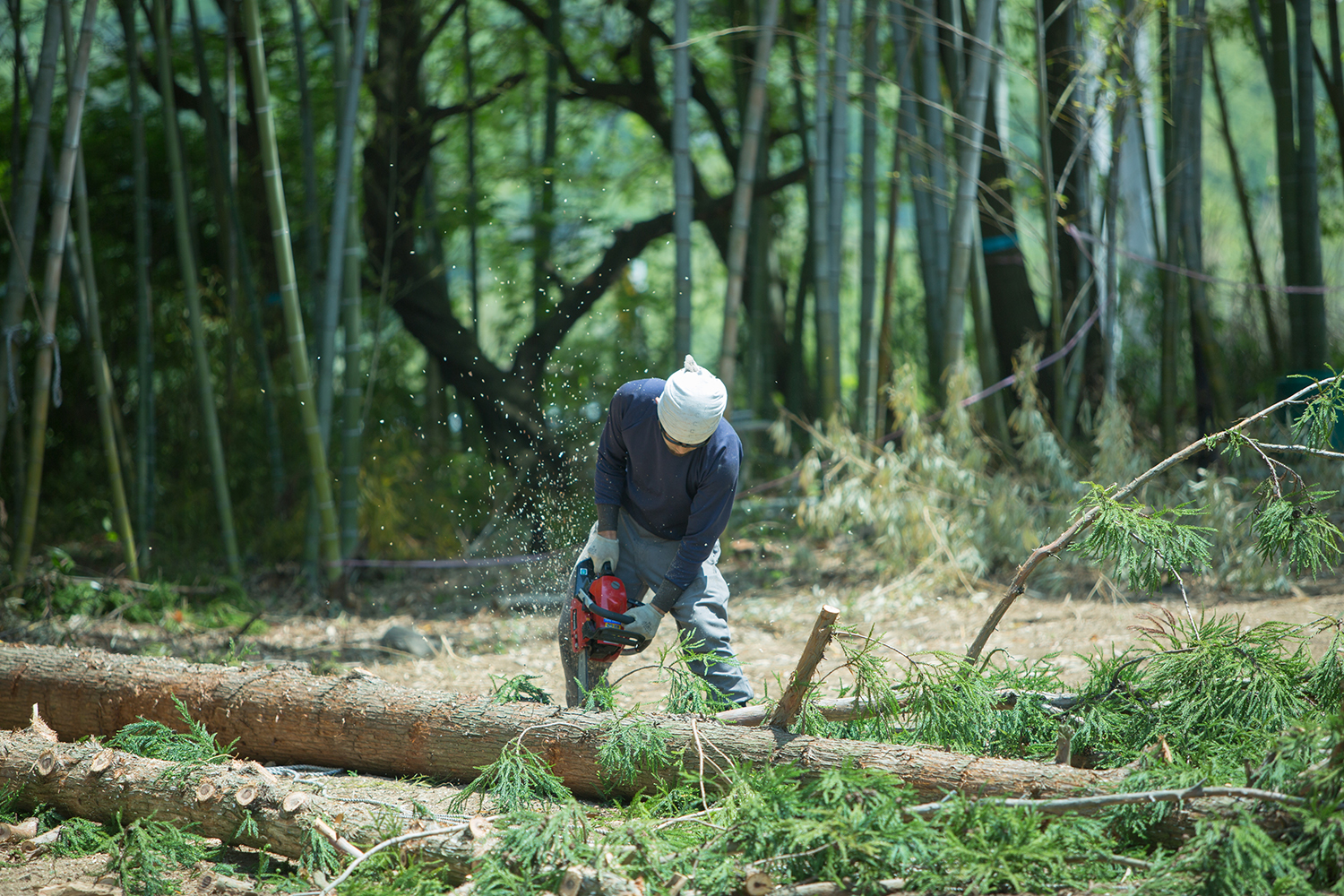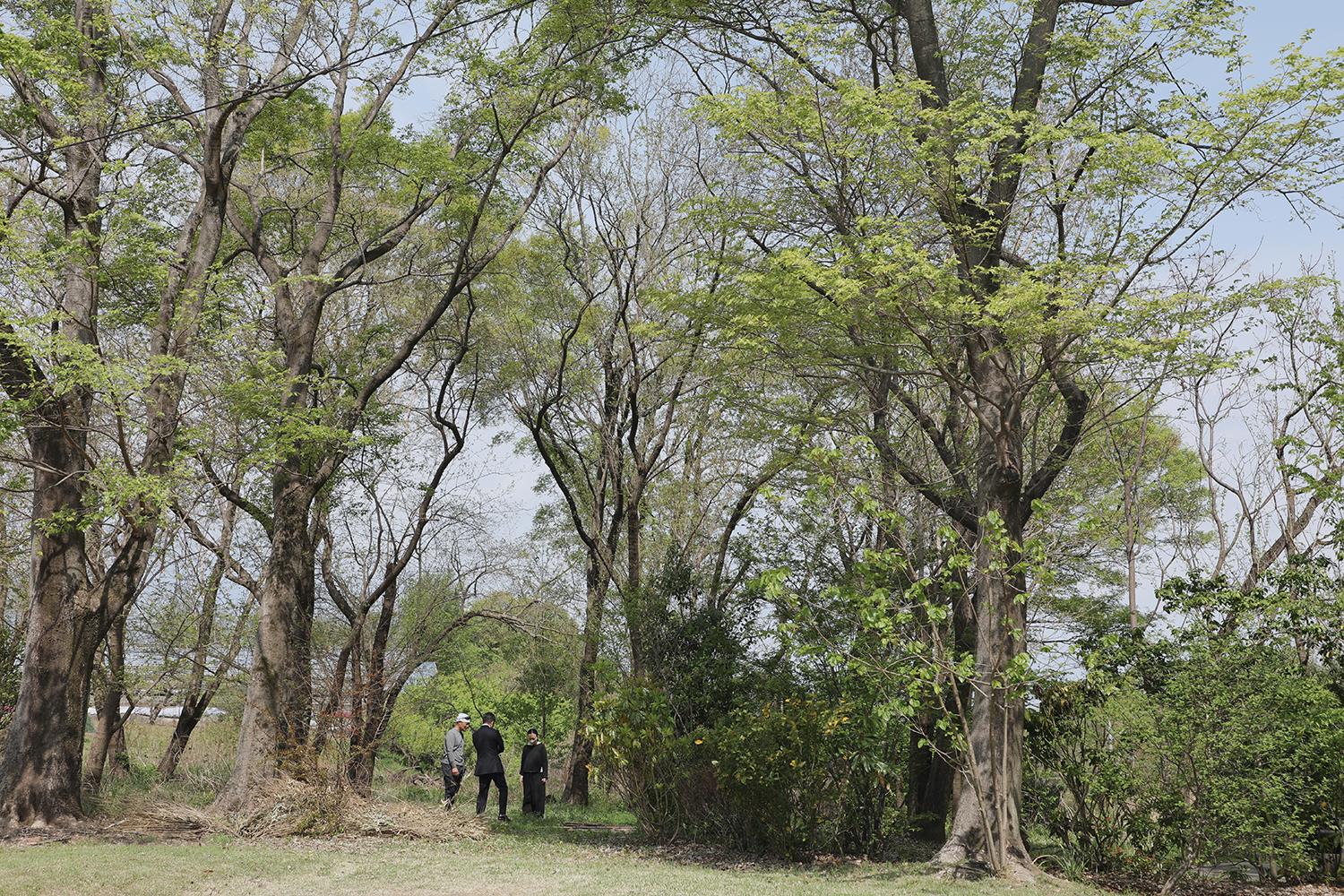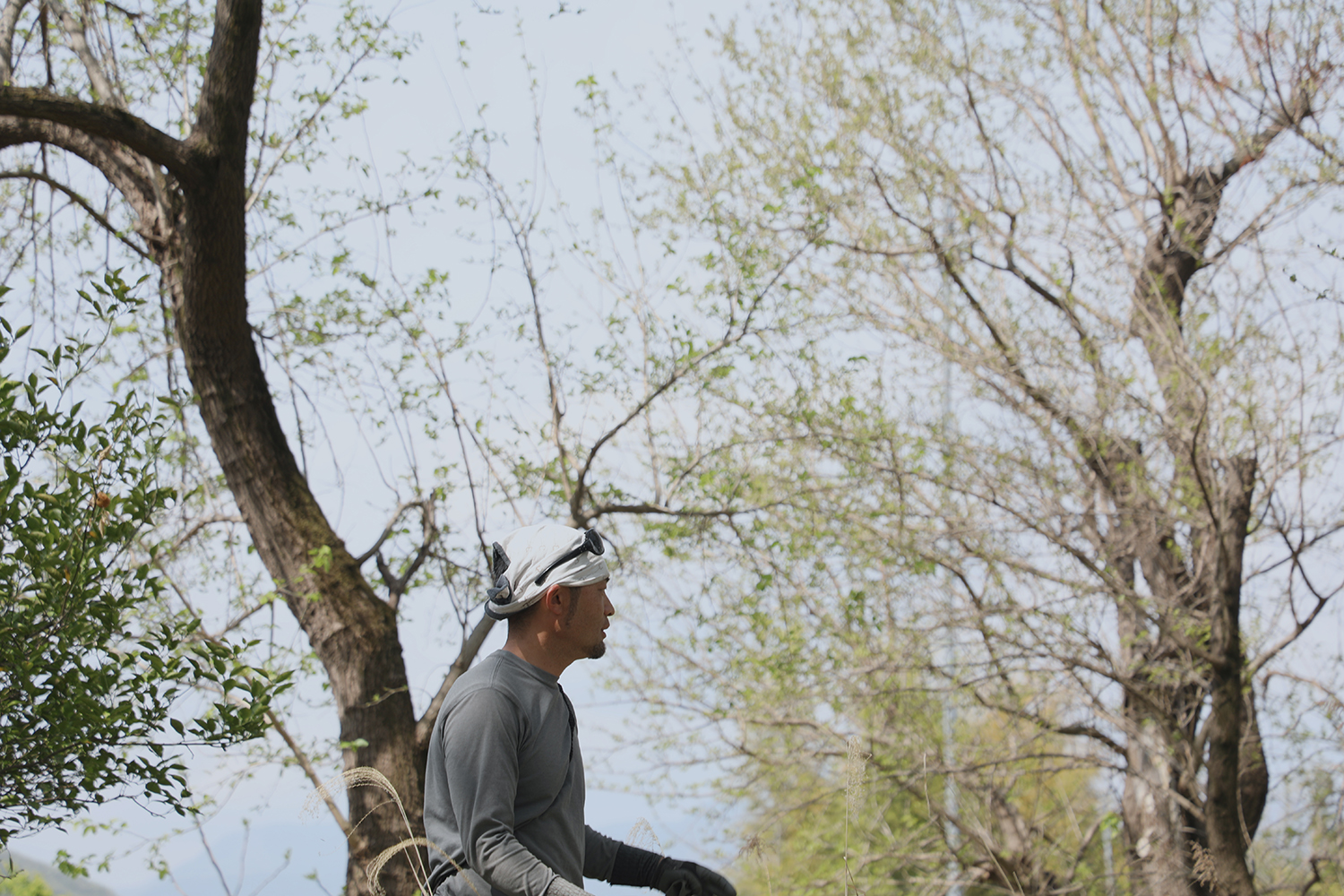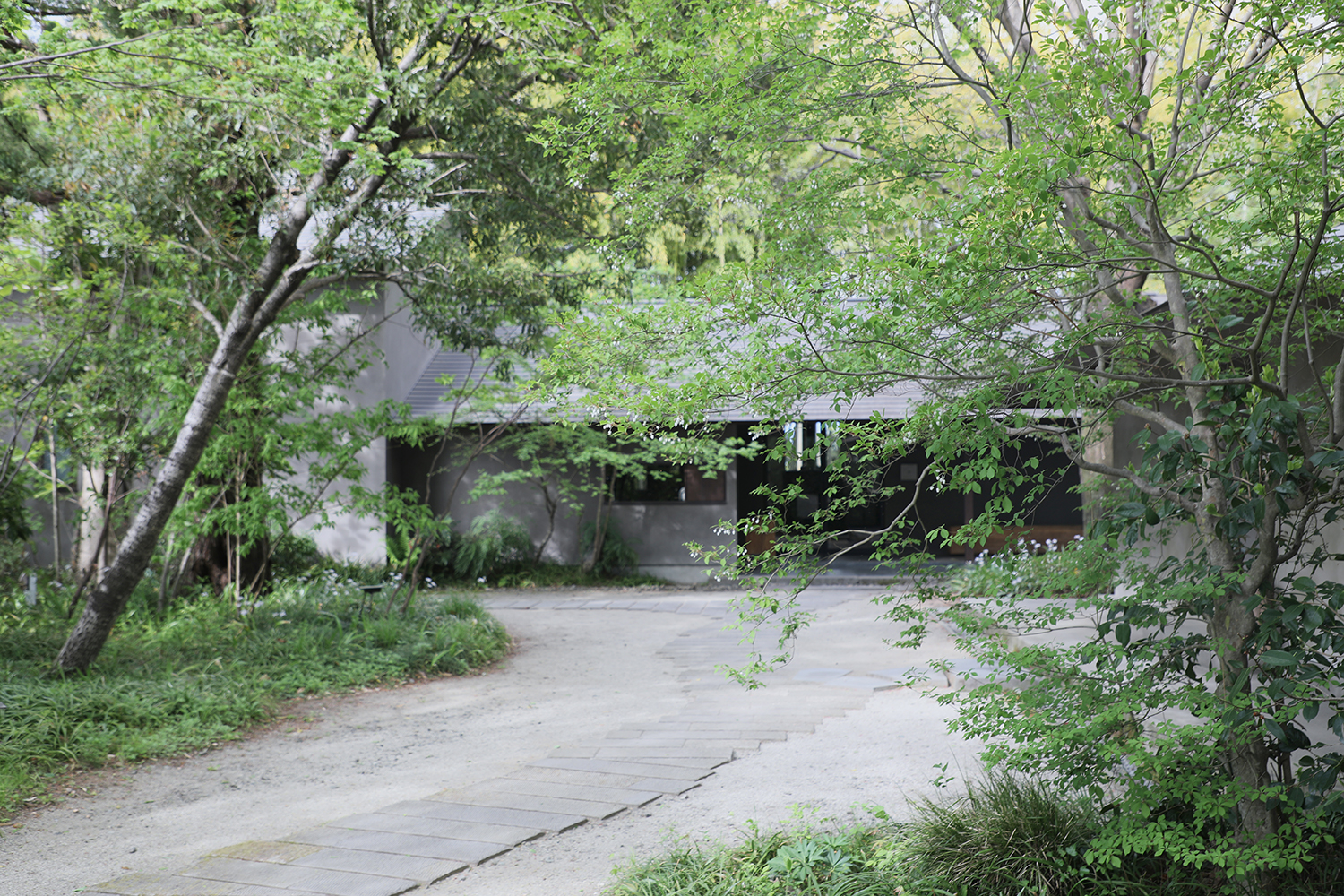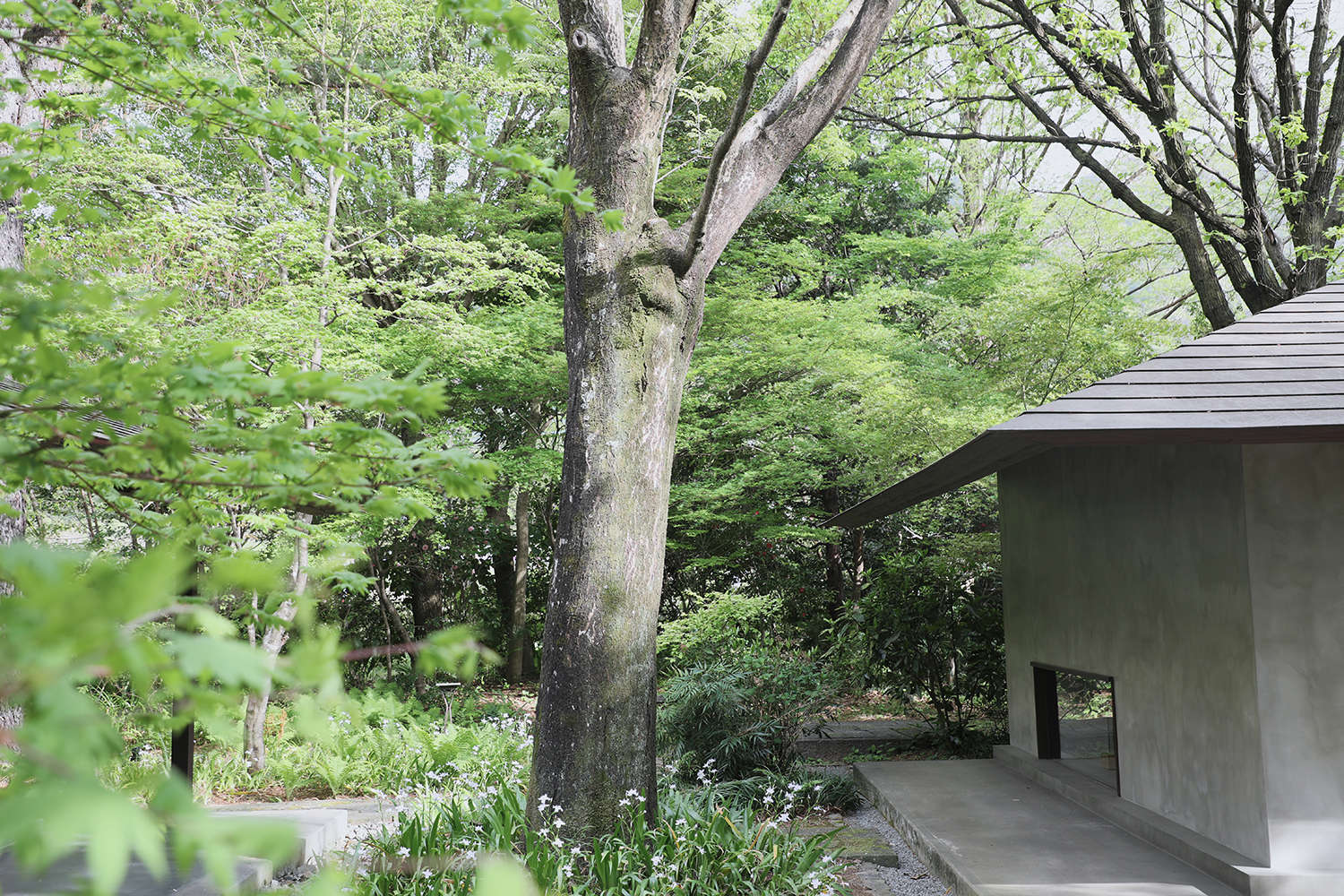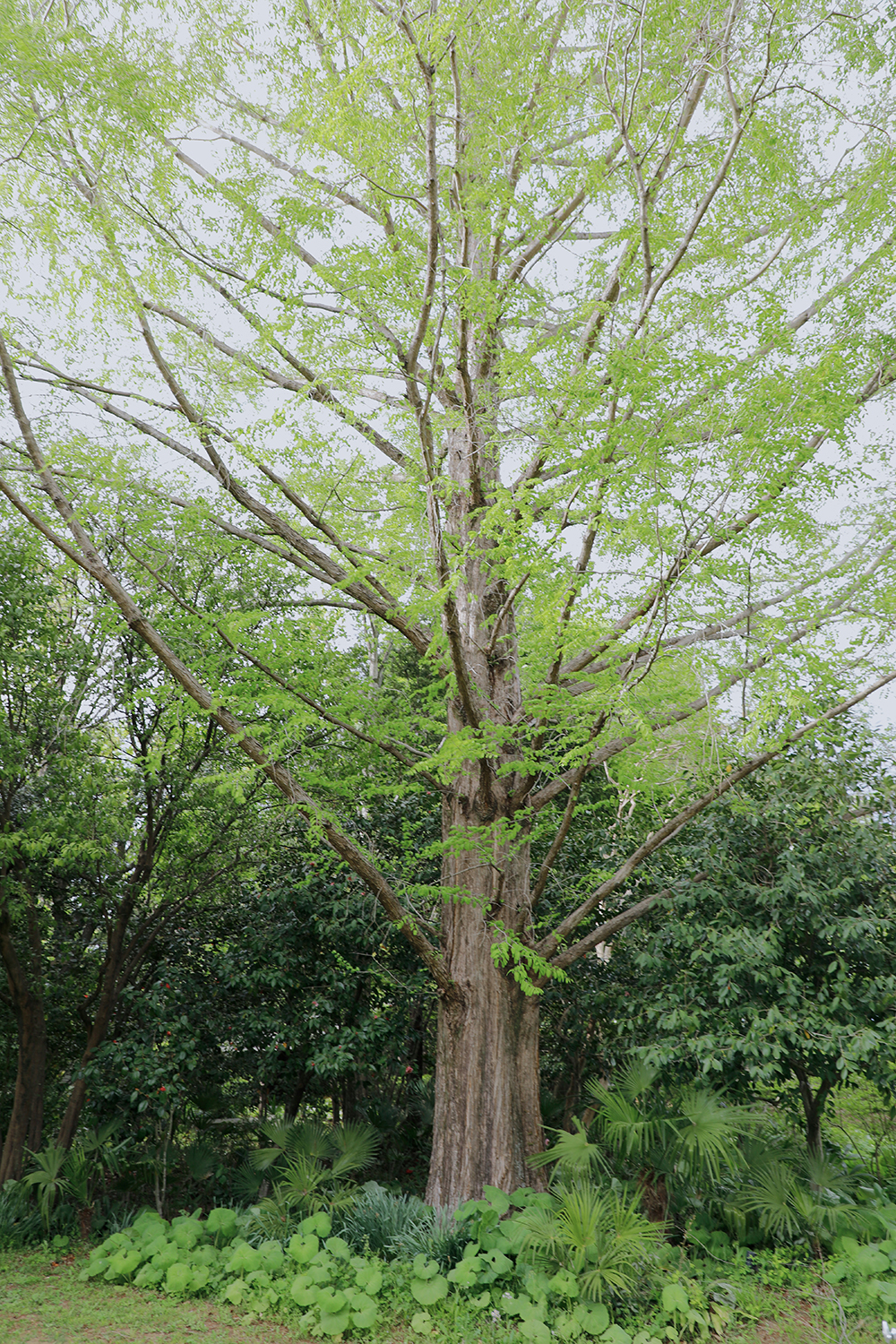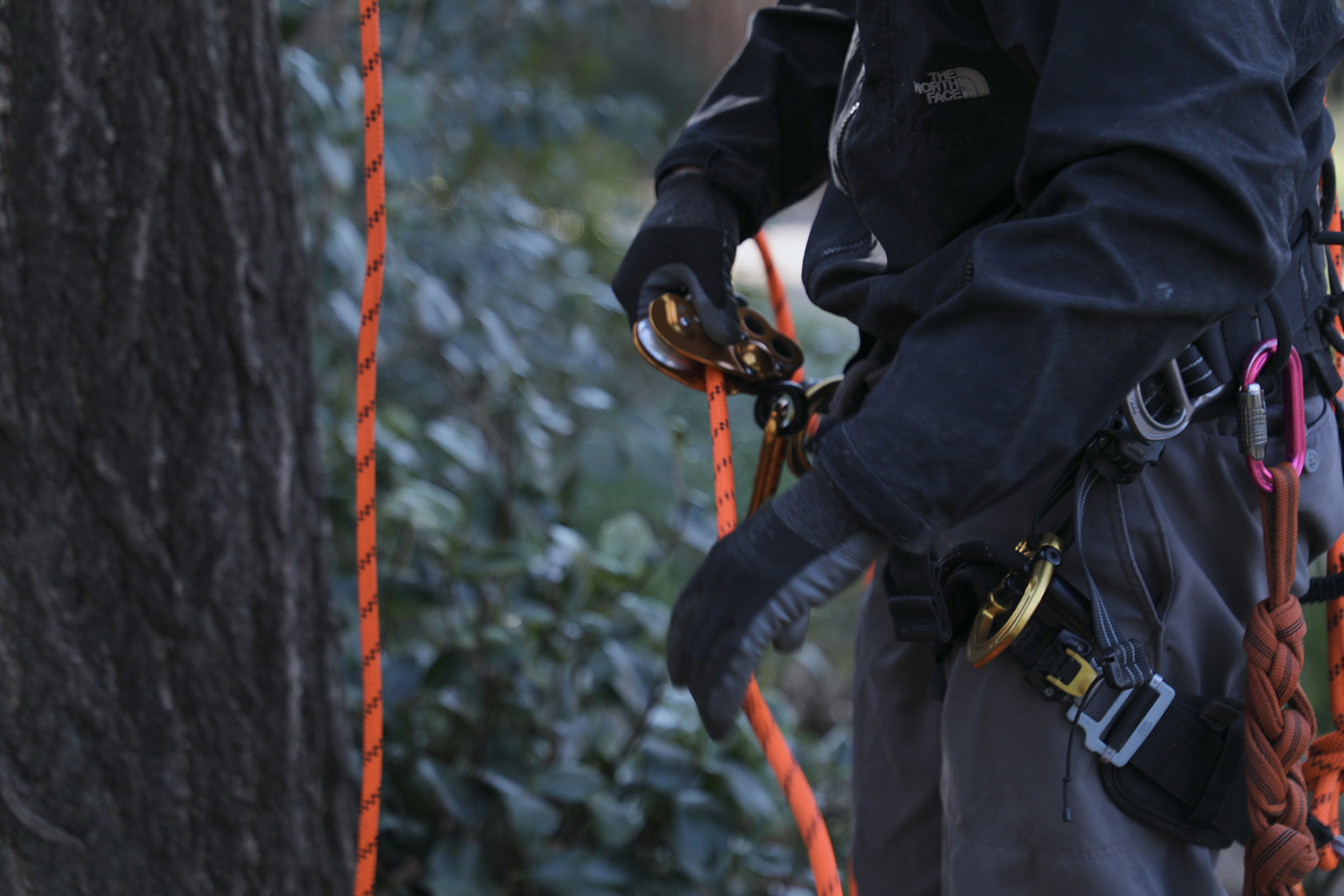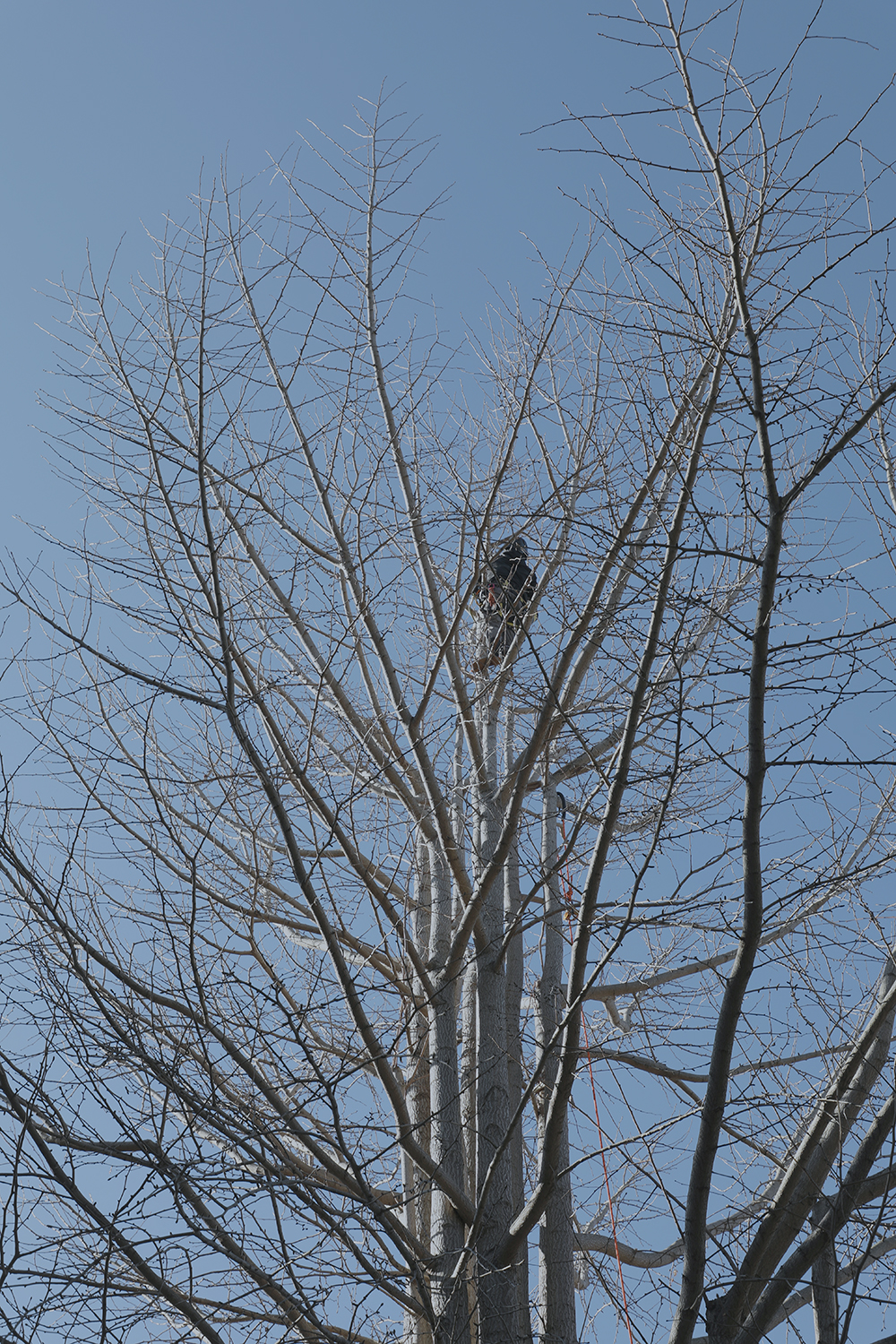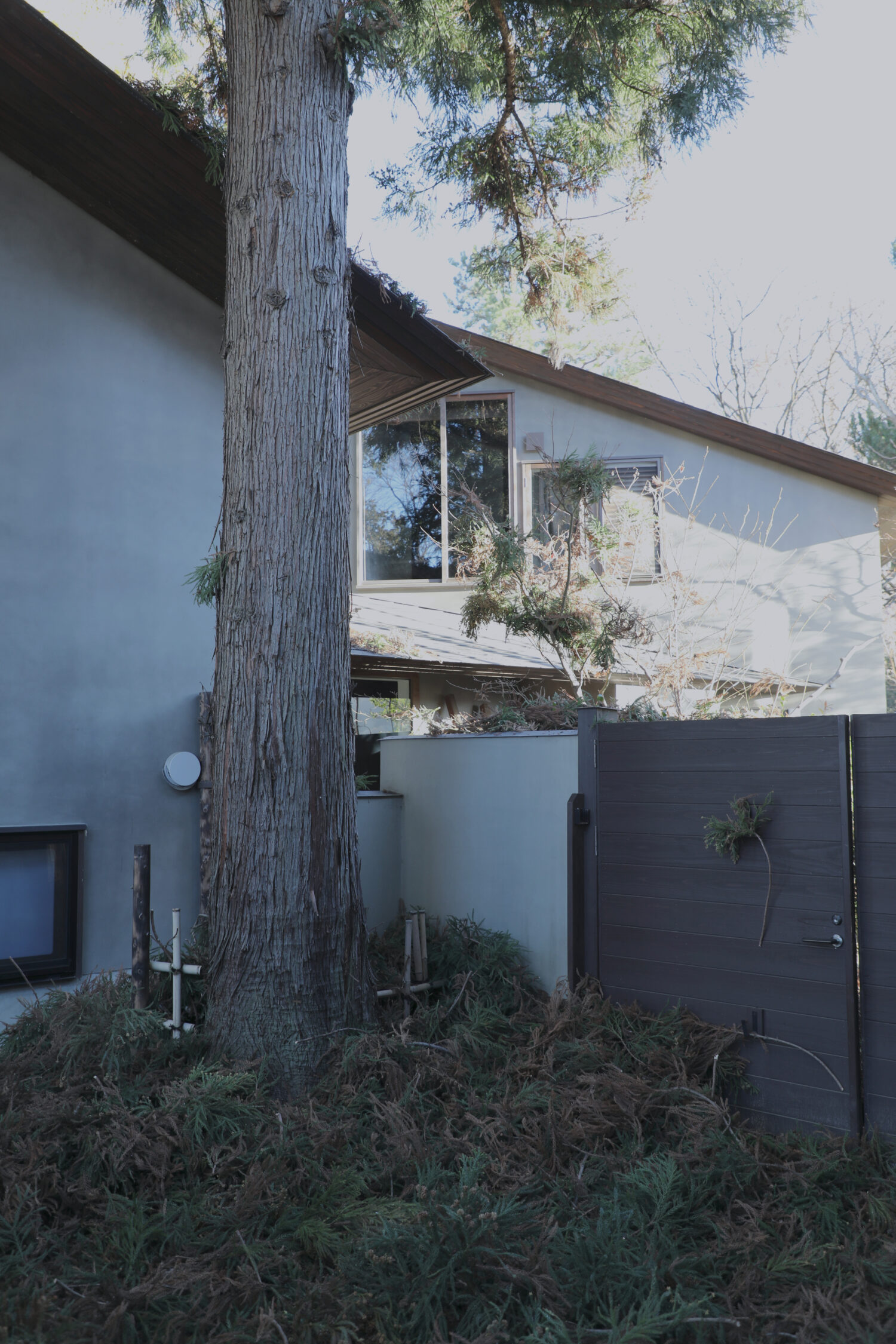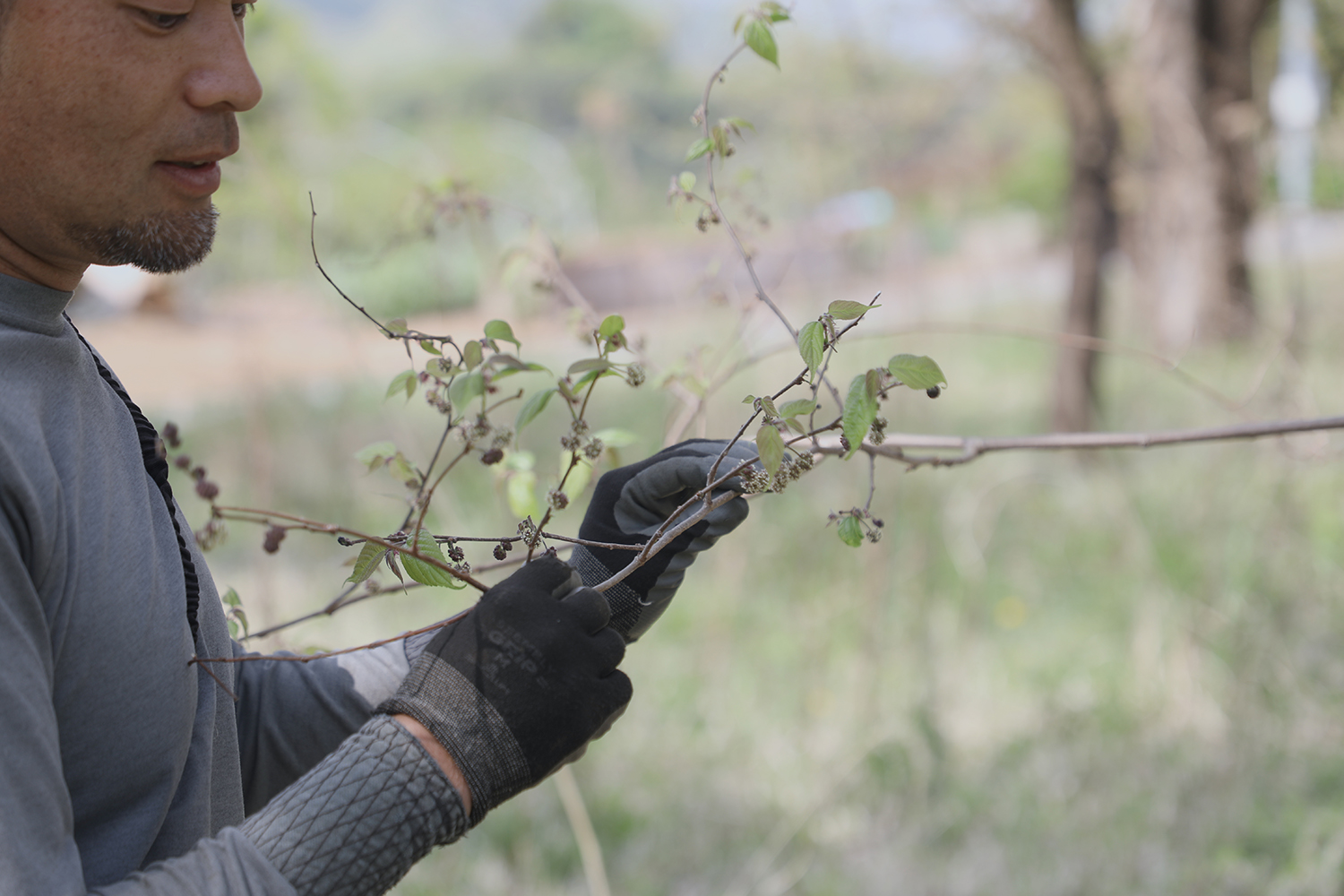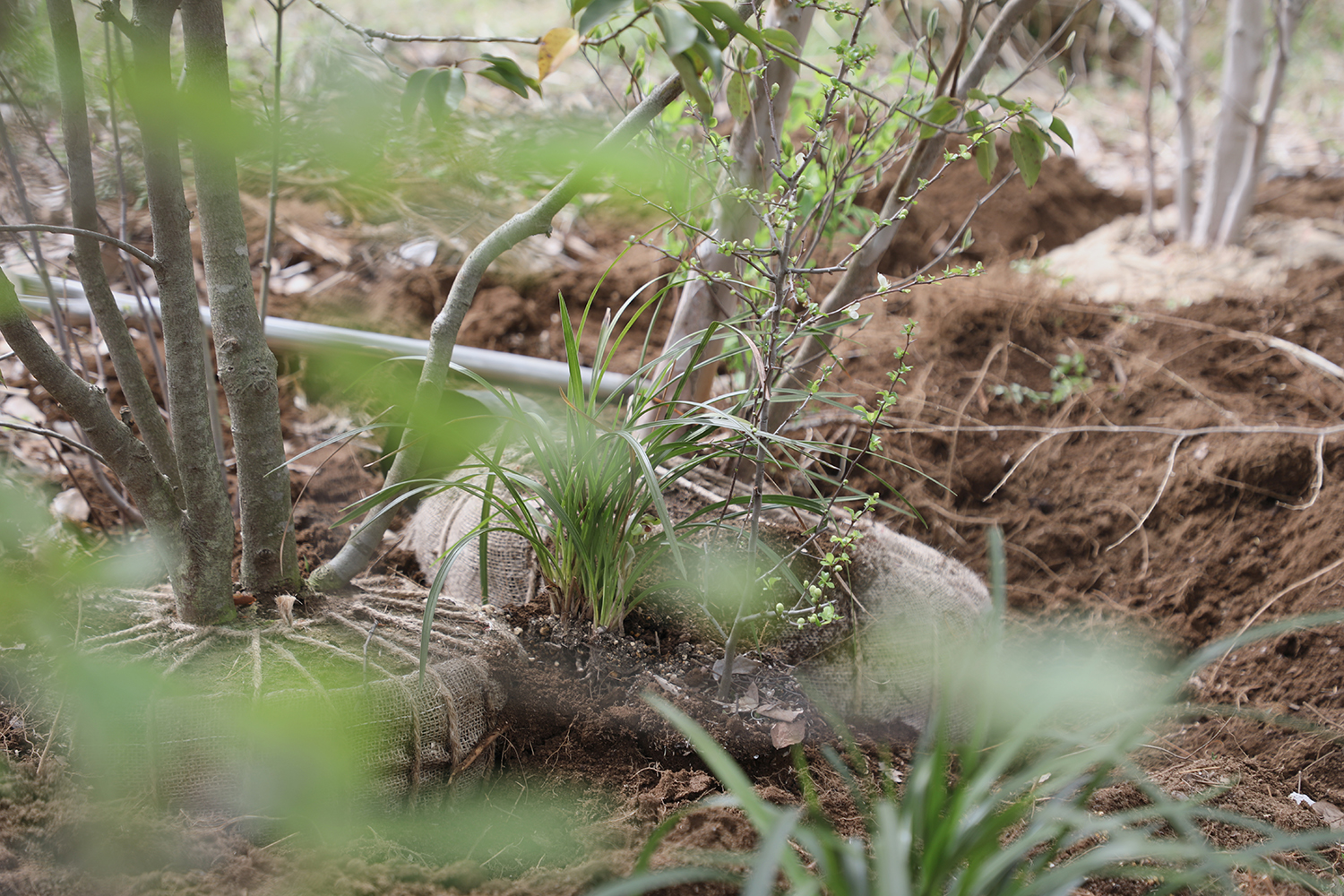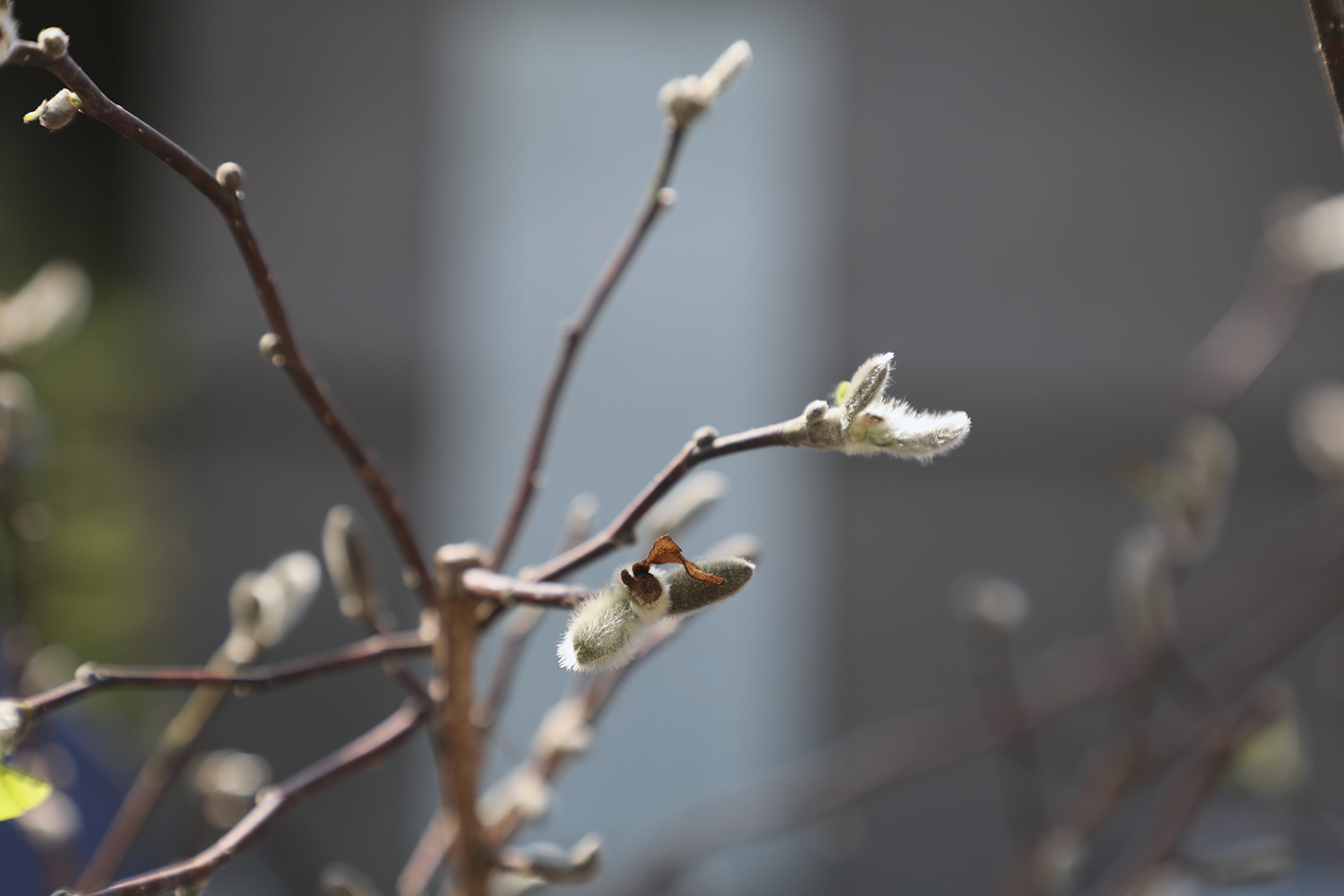四季折々の姿を見せる evam eva yamanashi 。春は青々と茂る樹々が清々しく、夏は茶房から臨む竹林が涼やかさをもたらし、秋は紅葉した葉が石畳を彩り、冬には澄んだ陽の光が景色を美しく照らします。それぞれの季節に咲く花や伸び広がる野草、枝葉を伸ばす樹々は、一見したところ自然そのままの姿のように見えますが、建築とランドスケープが融合するよう考えられ、手を入れながら育まれています。土地を共に開拓し、evam eva yamanashi のランドスケープを手掛けてくださっている彌永秀一さんにお話をうかがいながら、これまでの軌跡と evam eva yamanashi の四季を辿ります。
土地の記憶を辿る
山梨でお店を開きたいと思い、土地を探しているときに偶然見つけたこの場所。鬱蒼とした屋敷林の中に蔵がひっそりと佇み、時代の流れから取り残されたような、ここだけの空気が漂っていました。そこに暮らしていた人の営みの堆積も感じられ、なぜか不思議と心地よさがあったのです。ただそこには樹々が生い茂り、細かなメダケがびっしりと生え、2m先が見えず歩いて入ることもできない状態でした。そこに宿る心地よさの源を辿り、この先に繋ぐことを委ねる人として思い浮かんだのが彌永さんでした。2013年に初めてこの場を見ていただいてから10年、土地を開拓し、敷地内の何処に何が在り、なぜこの場所に根付いたのか文脈を辿りながら、受け継いだこの土地を現在の形へとつくり上げた過程についてお聞きしました。
「少しずつトリミングしていくと、南に開かれた門、古井戸、西門につながるみそ蔵、馬止め小屋の合間に、エンジュの木や竹藪の中からねじれたスモモの木、樹齢70年ほどの銀杏の木、この辺りでは珍しいメタセコイヤや三葉の松などの樹々が姿を現しました。山崎石と呼ばれる山梨で産出される石も沢山見つかりましたね。周辺の方にもお話をうかがいながら、この場所やそこに根付くものの歴史を掘り下げていきました」
建築よりも先にランドスケープを整えていきました。建物はそこで伸びやかに育つ樹々達の営む世界をできる限り壊さないで、ショップ「色」、レストラン「味」、ギャラリー「形」、3つの棟を敷地の中にどう位置付けていくのか、思考を重ね、相談を繰り返しました。
「建築が進み、敷地に対して建築物のボリュームが増えていった時も、最初にここを訪れた際に感じた心地良さを大切にしていました。前が見えず、その先に何があるのかという期待感や藪を抜けて開けた時の開放感など、最初の感覚が消えないように整えていきました。建物の存在感を抑えるために植栽したり、一つひとつの樹の枝ぶりを剪定したり。
洋服をデザインする時にどういったプロセスを経てつくられていくのか。ジャンルは違えど、ものをつくるという点で必ず共通することがあると思います。着心地や素材の質感を確かめながら紡いでいく evam eva のものづくりの在り方により近づけられたらという想いがありました。季節ごとに移ろう植物の情報をきちんと伝えながら、門をくぐった先、お店までのアプローチ、窓から見える景色、その空間一つひとつを話し合いながら創り上げていきました」
プロセスを共有し、人に委ねながら共に創り上げていくことは難しさもありますが、面白さも感じます。服も庭も建築も人がつくるものだから、ニュアンスを察することはとても難しい。けれど、議論し合い、それぞれの視点を融合することで、人と人、人と自然、自然と建築が心地よい距離感で繋がり合えるのだと思います。
人と自然を繋ぐ
開拓から現在に至るまで、evam eva yamanashi のランドスケープを担当してくださっている彌永さん。富士山の麓、鳴沢村を拠点に屋号「空庭」 からにわ で活動されています。
「美術系の大学へ進学し、学生時代は地面を切り取って花器をつくったり、土を塗り重ねたキャンパスを外に放置させたり、自然の風化に委ねた作品を制作していました。線が滲んだり、流れたり、自然の現象が介入してくることに面白さを覚え、自分の手を離れたところで時間の経過とともに作品が変化していくことに心地良さを感じていました。どちらかというと自分の中から湧き上がるものを形にするのではなく、自分がつくるものと自然とが共生することを仕事にしていきたいという漠然とした思いがありました。その時はそれが何なのかわかりませんでしたが。卒業後しばらくして建築内装を手掛ける会社に就職しました。その後、花屋でアレンジメントや生け込みに携わりながら、店舗のディスプレイの仕事も手掛けました。そのころから、庭や植物のことをちゃんと学びたいと思うようになり、26歳の時に造園の世界へ進みました」
ご結婚されたあとに奥様の出身地である山梨へ引っ越し、河口湖近くに居を構え、30歳で独立。奥様のお店である「うづらや」の庭から内装まで、全ての改修を自ら手掛けた彌永さん。庭だけにとどまらず、周辺の環境全てを取り込んで、そこにしかない風景を形にしているところが強みです。現在、能登にある海辺のオーベルジュや奥多摩の古民家ホテル、韮崎に新設される保育園など、いくつかのプロジェクトのランドスケープを担当しています。彌永さんが庭づくりで大切にしていることをうかがいました。
「その土地の土壌がどんな状態なのか、潜在的な植生がどうあるのかといった自然的文脈と、その土地に生きてきた人の歴史的文脈とを先ず理解することを大切にしています。人の手があまり入っていないところでは、ある程度安定した森がつくられています。その中には多様な植生が残っていて、大きな樹木やその下に生える下草、昆虫などの小さな生き物や菌類等と関係を持ちながら一つの生命体として成り立っています。人が自然に関わることで潜在的にあったものがなくなることもありますが、人が100年関わり続ければ、それが新たな自然の姿になる。人の手が加わることで、自然はより穏やかに安定して成長することも可能だと考えています。同時に人が暮らす枠の中だけで完結しないように、森の営みとの繋がりもきちんと残すようにする。その土地の文脈を踏まえつつ、関係性と折り合いをつけながら、程よい距離感を保てる場所を提案したいと思っています」
自然と向き合いながら、小さなやりとりで人と自然を繋ぐ。それは木を植えることである時もあれば切ることである時も。時にはお隣さんにお花をおすそ分けすることだったりするのかもしれません。
冬から春への庭支度
心地よさを生み出してくれる大きな樹木。最近の日本では、台風などの災害で倒れてしまうこともあるため敬遠されがちですが、かつて人と大きな樹々は今よりももっと身近な関係にありました。屋敷森や里山の森を維持しながらそれらの循環の中で共に生きてきました。雄大な樹々とともに穏やかな時間が流れる evam eva yamanashi の景色を維持するため、彌永さんはツリークライミングの技術を習得したり、樹木医の資格を取得し、植物たちが健やかな状態で芽吹き、咲き続けられるように、季節に合わせながらケアしてくださっています。
「高所作業車が入れない場所での剪定は、直接木に登る必要があります。ツリークライミングを学んだことで安全に枝先まできちんと剪定でき、風の影響を抑えながらより自然な枝ぶりの樹形を維持することができます。
落葉樹は春や夏に剪定すると切り口から水分が滲み出て、湿ったままの切り口に菌が繁殖して腐りが入ってしまいます。10mを超える大きな木は樹体に対するダメージが少ない休眠期間の冬に剪定しています」
「大きな樹が倒れてしまうと景色ががらりと変わってしまうので、植物の摂理や自然環境の中での植生を知り、健康状態を確認しながらケアすることが重要になってきます。樹自体を小さくすればよいという考えもありますが、ここまで守り育てられてきた樹々にできるだけ自然なまま大きく、生長し続けてほしいという想いが根底にあります」
自然への尊崇の眼差しと謙虚な姿勢が清々しい彌永さん。植物に興味を持ち、学ぼうとし続ける探究心の深さがあるからこそ、evam eva yamanashi の植物たちがより自然に近い姿で在り続けられているのだと思います。
この日は春から夏にかけて花をつける庭木の植え込み作業。山で見かけた花木や、活け込みに使いやすい枝葉のはり方をする樹木など、小さな相談を投げかけても、その一つ一つに丁寧に向き合ってくださいます。
開拓から数年の時を重ねるなか、風や鳥によって運ばれた種子が芽生えたり、眠っていた植物が目覚めたり。身近な自然に身を寄せることで新たな気付きがあり、共生することの大切さを感じます。
evam eva yamanashi は、6年目の春を迎えました。これまでもこれからも、草花、樹々、土地から与えられる自然の恵みに支えられながら、人と自然によって育まれる心地よいこの場所で、日々の生活を彩る「もの」「こと」そして “とき” をみなさまと分かち合いたいと思います。次回は夏から秋への移ろいと、道を照らす光のあり方についても触れてみたいと思います。
彌永秀一
1978年広島県福山市生まれ。金沢美術工芸大学油画専攻卒業後、造園会社に就職し庭を学ぶ 。2009年に独立し、空庭を設立。庭の仕事を軸に、自然と人との関係を考える。
website|http://karaniwa.sakura.ne.jp/
photographer:砺波周平
*写真2枚目から7枚目まで
緑豊かな5月、お庭に人々が集い、食事を愉しんでいただけるイベントを開催いたします。「食べる」ことをより愉しめるマルシェでは、テーブルを彩る草花や新鮮な野菜、季節の食材を使った焼き菓子やジャム、テーブルウェアなどさまざまな品が揃います。お庭の席でお召し上がりいただけるお食事もご用意いたしております。季節の色と香りに溢れたお庭を、体と心で感じてください。
Eat and Marché
日程|5.13(土)14(日)
日時|11:00 – 17:00
会場|evam eva yamanashi
shop list
ishihara nursery
ベーストヨトミ
sundaysfood
AKITO COFFEE
菜と果
ヒグチビクトリアンケーキ
豊鮨[eat]
やまゆり[eat]*13日のみ and more…
詳細はウェブサイトをご覧ください。
https://evameva-yamanashi.jp
column|Garden from winter to spring
evam eva yamanashi is a place that changes with the seasons. At first glance, the flowers and trees that grow in each season appear to be in their natural state, but they have been carefully considered and nurtured so that the architecture and landscape blend with each other. We will trace the history of evam eva yamanashi and its four seasons by interviewing Mr. Shuichi Yanaga, who developed the land together and is in charge of evam eva yamanashi’s landscape.
Tracing memories of the land
We found this place by chance when we were looking for land to open a store in Yamanashi. We could feel the accumulation of the lives of the people who lived there, and for some reason, there was a sense of comfort. Mr. Yanaga came to mind as the person to whom we could trace the source of the comfort that resides there and entrust the connection to the future. We asked Mr. Yanaga about the process he went through in the 10 years since he first saw the site in 2013, cultivating the land, tracing the context of where things existed and why they took root here, and transforming the land he inherited into its current form.
“As I trimmed little by little, between the gate that opened to the south, the old well, the miso warehouse leading to the west gate, and the horse stalls, we found an japanese pagoda tree, a twisted plum tree among bamboo thickets, a 70-year-old ginkgo tree, a metasequoia tree and a three-leaf pine , which are rare in this area. I also found many stones produced in Yamanashi called Yamazaki stones. While talking to people in the neighborhood, I delved into the history of this place and the things that take root there.”
We started by preparing the landscape before the architecture. We repeatedly discussed how to position the three buildings – store “Iro”, restaurant “Aji”, and gallery “Katachi” – on the site without destroying the world of the trees growing there as much as possible.
“As construction progressed and the volume of buildings increased in relation to the site, I kept in mind the sense of comfort I felt when I first visited here. I made sure that the initial feeling of anticipation of what lay ahead with not being able to see ahead, and the feeling of openness when you pass through the bushes and open up, did not disappear. I planted trees to reduce the presence of the building and pruned the branches of each individual tree.
I wanted to bring it closer to the way evam eva creates its clothes, which involves checking the comfort of the clothes and the texture of the materials. We discussed and created each space, from the gate, to the approach to the store, to the view from the window, while making sure to communicate information about the plants that change with the seasons.”
Sharing the process and entrusting it to others to create together is difficult, but also interesting. Clothes, gardens, and architecture are all created by people, so it is very difficult to perceive the nuances. However, by discussing and integrating the perspectives of each person, I believe that people and people, people and nature, and nature and architecture can connect with each other with a comfortable sense of distance.
Connecting people to nature
Mr.Yanaga has been in charge of evam eva yamanashi’s landscape from the pioneering days until now. He is based in Narusawa Village at the foot of Mt.Fuji under the trade name “Karaniwa”.
“I went to an art college and when I was a student, I made vases by cutting up the ground, left the campus outside with layers of soil painted on it, and created works that were left to the weathering of nature. I was fascinated by the intervention of natural phenomena, such as the blurring and flowing of lines, and felt comfortable with the way the work changed over time, away from my hands. A short time after graduation, I found a job at a company dealing with architectural interiors. Later, I worked in a florist shop arranging flowers, and also worked on store displays. Around that time, I began to think that I wanted to learn more about gardens and plants, and at the age of 26 I entered the world of landscaping.”
After his marriage, he moved to his wife’s hometown in Yamanashi, settled near Lake Kawaguchi, and became independent at the age of 30. Currently, he is in charge of landscape design for several projects, including a seaside auberge in Noto, an old private house hotel in Okutama, and a new nursery school to be built in Nirasaki. We asked Mr. Yanaga what he considers important in creating a garden.
“I place importance on first understanding the natural context of the land, such as the condition of the soil and potential vegetation, as well as the historical context of the people who have lived on the land. I believe that with the addition of human intervention, nature can grow in a more peaceful and stable manner. At the same time, I try to preserve the connection with the workings of the forest so that the work is not completed only within the framework of human life. I would like to propose a place that maintains a good sense of distance while taking into account the local context and coming to terms with the relationship.”
Facing nature, he connects people with nature through small interactions. Sometimes it is planting a tree, and sometimes it is cutting it down. Sometimes it may be to share flowers with the neighbor.
Preparing the garden from winter to spring
Large trees create a sense of comfort. In Japan these days, trees tend to be shunned because they can fall down in typhoons and other disasters, but in the past, people and large trees had a closer relationship than they do today. They have lived together in those cycles, maintaining the forest planted around the house and woodland close to the villages. In order to maintain the peaceful landscape of evam eva yamanashi with its majestic trees, Mr.Yanaga has acquired tree climbing skills and certification as an arborist, and takes care of the plants in season so that they can sprout and bloom in good health.
“Pruning in areas where high clearance vehicles are not allowed requires climbing directly on the tree. Learning to tree climb allows me to safely prune properly to the tips of the branches and maintain a more natural branching form while reducing the effects of wind.
For deciduous trees, pruning in the spring or summer allows moisture to seep through the cut, causing fungus to grow in the moist cut and rot to set in. Large trees over 10 meters in height are pruned in the winter during the dormant season when there is less damage to the tree body.”
“When a large tree falls, the landscape changes drastically, so it is important to care for the tree while checking its health based on the knowledge of plant regimes and the vegetation in the natural environment. There is the idea that the trees themselves should be reduced in size, but at the core of my desire is that the trees that have been protected and nurtured up to this point continue to grow and develop in as natural a manner as possible.”
Mr.Yanaga’s reverence for nature and humble attitude are refreshing. I believe that it is because of his deep interest in plants and his continuous quest to learn more about them that the plants at evam eva yamanashi are able to remain as close to their natural state as possible.
On this day, we were planting garden trees that bloom from spring to summer. Whenever we asked for advice on a small matter, such as a flowering tree we saw in the mountains or a tree with branches and leaves that would be easy to use in a flower arrangement, he would carefully respond to each question.
Over the years since pioneering, seeds carried by wind and birds have sprouted, and plants that had been sleeping have awakened. By being close to nature, new insights are gained and the importance of coexisting with nature is felt.
evam eva yamanashi has entered its 6th year of spring. We have been and will continue to share with you the “things”, “matter”, and “times” that color our daily lives in this comfortable place nurtured by people and nature, supported by flowers, plants, trees, and the bounty of nature provided by the land.
In the next issue, we would like to discuss the transition from summer to autumn and the way light illuminates the path.


